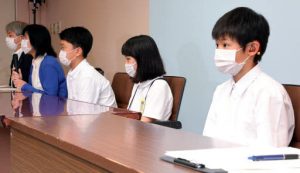August 6 amid pandemic: Hiroshima City announces plan for 24 representatives of A-bombing victims’ families to attend Peace Ceremony
Jul. 10, 2021
Participant seating will be 10 percent of typical number
by Tsuyoshi Kubota, Staff Writer
On July 9, the Hiroshima City government announced its general outline for this year’s Peace Memorial Ceremony to be held on August 6 at the Hiroshima Peace Memorial Park, in the city’s Naka Ward. Due to the coronavirus pandemic, current plans call for 24 representatives of A-bombing victims’ families to attend the ceremony from Japan’s various prefectures, the second fewest following last year, when the number was 23. Participant seating at the ceremony venue will be reduced to a maximum of 880, 10 percent of the number usually set aside, to prevent transmission of the virus, the same measure taken at last year’s event. The city government is asking the public to refrain from visiting the park at the time of the ceremony to avoid overcrowding.
According to the city, 24 representatives of bereaved families, one from each of Japan’s prefectures, will participate in the ceremony. Although the number of participants is one more than that of last year, which was a result of the pandemic at that time, it falls far below the 36 recorded in 2017 and 2019, which were all-time lows to that point in time. The average age of the 24 representatives this year is 70.9 years, with the oldest person being 90 years of age and the youngest 56.
Regarding overseas attendees, 93 nations and regions, 10 more than last year, responded affirmatively that they would send representatives to attend. Representatives of the European Union (EU) are also expected. If no changes are forthcoming in participation, it would become the second-largest number of countries to attend the ceremony, following the 100 recorded in 2015, the year marking the 70th anniversary of the atomic bombing.
Among nuclear-armed nations, the United States, Russia, the United Kingdom, France, India, and Israel accepted the invitation to attend, while China and Pakistan declined. Hiroshima did not send an invitation to North Korea, since that country does not have an embassy in Japan.
The peace ceremony will begin at 8:00 a.m. and is scheduled to last for 50 minutes. The “Peace Bell” will be tolled by Hidemi Murata, 58, a representative of the victims’ families and a resident of Higashi Ward, and Nagisa Ishida, 11, a sixth-grade student at Yahata-higashi Elementary School who is a children’s representative living in Hiroshima’s Saeki Ward. “Commitment to Peace” will be read aloud by two sixth-graders, Maria Ito, 12, from Fukuromachi Elementary School who lives in the city’s Naka Ward, and Yoshimasa Takumi, 11, from Itsukaichi-higashi Elementary School who lives in Saeki Ward.
A wind ensemble and chorus composed of high school students, a portion of the event that was canceled last year, will be performed at a reduced scale compared with past years. The “Release of Doves,” a proceeding that will be held as soon as Hiroshima Mayor Kazumi Matsui finishes reading the “Peace Declaration,” will resume for the first time in two years.
Seating for participants, which typically numbers 11,500, will be reduced and placed two meters apart to prevent any spread of the coronavirus. Seating typically available for the general public or for elementary and junior high school students who visit Hiroshima from throughout Japan for peace studies will not be set up for this year’s event.
“Though there will not be many visitors, we will try our best to send out our message of peace,” said Tadaharu Hashiba, deputy chief of the city’s Citizens Affairs Bureau, at a news conference in Hiroshima’s City Hall. “We hope that all citizens can join us in a prayer for peace wherever they are by watching the streamed event.”
(Originally published on July 10, 2021)








